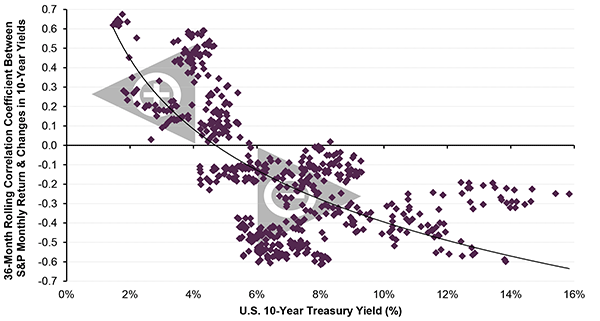Escape Velocity in the Economy
The broad improvement in U.S. economic data indicates that the economy is likely to continue to expand, supporting earnings growth and pointing to an eventual return of leveraged buy outs.
by Scott Minerd, CIO, Guggenheim Partners LLC
The U.S. economy is reaching "escape velocity," powered by the monetary rocket fuel from central banks around the world. Almost every domestic economic indicator is now positive and the economic backdrop is stronger than it has been in the last seven years. We are in the healthiest financial condition since 2003. If the post-2003 experience were to be repeated, we could see an uninterrupted economic expansion for four years. Although pockets of uncertainty remain, such a favorable outlook for the economy and markets cannot to be ruled out.
Investors can expect a continuation of the themes that have dominated the environment since the recovery began: tighter credit spreads, low interest rates, improving employment, modest inflation, and sustained economic growth. Historically low interest rates and continued earnings growth will support higher equity valuations. As leveraged buy-outs come back into play, undervalued companies with large cash balances are sure to be targets. More merger and acquisition activity would lift share prices higher, furthering the expansionary trend that is already underway.
Economic Data Releases
Further Evidence of a U.S. Housing Recovery
• The NAHB index of homebuilder confidence stayed at a six-year high of 47 in January, with housing starts in December rising to their highest level since June 2008.
• The FHFA house prices grew 0.6% month-over-month in November, the second consecutive month of increase.
• Although existing home sales fell slightly to an annual rate of 4.94 million in December, this is still the second highest level since November 2009.
• Initial jobless claims for the week of January 12th fell to 335,000, the lowest level in five years.
• Industrial production rose 0.3% in December, aided by a robust gain of 0.8% month-over-month in manufacturing.
• Regional manufacturing indices disappointed in January, as both the Philadelphia Fed’s economic index and the Richmond Fed manufacturing index turned negative from their positive readings in December.
• The University of Michigan consumer sentiment index fell to 71.3 in January, the lowest since December 2011.
• The Consumer Price Index remained unchanged from November to December, with a year-over-year reading of 1.7%.
European Sentiment Improves, China Accelerates
• According to the flash estimate, eurozone consumer confidence improved for a second month in January to -23.9.
• The ZEW survey of expected economic growth in Germany jumped to 31.5 in January, the highest since May 2010.
• U.K. retail sales (excluding fuel) declined 0.3% in December versus an expected 0.1% gain, while jobless claims fell by 12,100 in December to a one and half year low of 1.56 million.
• In Italy, industrial orders fell 0.5% month-over-month in November after gaining in October, and industrial sales slipped 0.2%.
• The eurozone’s year-over-year inflation remained unchanged at 2.2% in December.
• In China, fourth quarter real GDP rose 7.9% from 7.4% in the third quarter, the first year-over-year acceleration in two years.
• China’s industrial production and retail sales also continued to accelerate in December, growing at 10.3% and 15.2%, respectively.
Chart of the Week
Rising Yields’ Positive Effect for Equities
Empirical studies suggest that an increase in the Treasury yields does not necessarily lead to weaker equity performance. When yields on the 10-year note remain below 4%, the correlation between S&P 500 monthly returns and changes in 10-year yields are positive, which implies that when yields rise, equity prices move higher as well. An increase in interest rates from a low level is likely to be the result of more robust economic activity, which is positive for equity performance. When the 10-year Treasury yield climbs above 6%, the correlation inverts, with increasing yields leading to decreasing equity prices. This occurs because of the affiliated rise in the inflation premium, which is negative for input prices and earnings, putting downward pressure on equity prices. Given that the 10-year Treasury yield is currently around 1.83%, for now, any potential rise in yields should result in an increase in equity prices.

Source: Bloomberg, Guggenheim Investments. Data as of 12/31/2012.
This article is distributed for informational purposes only and should not be considered as investing advice or a recommendation of any particular security, strategy or investment product. This article contains opinions of the author but not necessarily those of Guggenheim Partners or its subsidiaries. The author’s opinions are subject to change without notice. Forward looking statements, estimates, and certain information contained herein are based upon proprietary and non-proprietary research and other sources. Information contained herein has been obtained from sources believed to be reliable, but are not assured as to accuracy. No part of this article may be reproduced in any form, or referred to in any other publication, without express written permission of Guggenheim Partners, LLC. ©2013, Guggenheim Partners. Past performance is not indicative of future results. There is neither representation nor warranty as to the current accuracy of, nor liability for, decisions based on such information.
Copyright © Guggenheim Partners LLC













